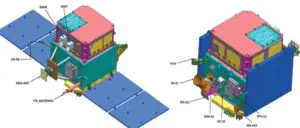Table of Contents
Neutrinos its Misconceptions and Significance | UPSC – IAS
What are Neutrinos particles ?
- The elusive neutrinos are second most abound particles in the universe, yet a lot more is to be understood about them.
- They interact very little with anything and pass through everything that’s why it’s hard to detect them.
- They carry no electrical charge and nearly massless.
- It occurs in 3 different types/flavors, separated based on mass (electron-neutrino, muon-neutrino, tau-neutrino).
- It is produced in the core of the sun & millions of them roam around in the solar system.
- They are key to understanding the evolution of universe and energy production in the Sun and the stars.
Misconceptions related to neutrinos | UPSC – IAS | Pib
Several misconceptions related to neutrino research led to common opposition to the project
- Harmful to the human body: They are least harmful of elementary particles, as they hardly interact with matter. In fact, trillions of solar neutrinos pass through our body every second without doing any harm to us.
- Effect of the associated radiation: No radiation is involved as INO only studies atmospheric neutrinos produced by cosmic rays in the atmosphere.
- Potential uses in weaponization: They are often confused with neutrons, which can be used to produce nuclear weapons.
Other neutrino study projects
- LAGUNA (Large Apparatus studying Grand Unification & Neutrino Astrophysics) in Europe
- Hyper Kamiokande Detector at Kamioka Observatory in Hida (Japan)
- DUNE (Deep Underground Neutrino) project in South Dakota (US)
Significance of India-based Neutrino Observatory (INO) | UPSC – IAS | Pib
- It will give a boost to scientific studies in India and encourage students to take up Science and Research as profession.
- It has been gaining urgency in the recent years with China announcing the construction of a similar neutrino observatory in Jiangmen province.
- Nicknamed the ‘blueprint of nature’ by scientists, neutrinos are an important tool for mankind to learn how matter evolved from simple particles into more complex composites, creating everything around us.
How neutrino research is useful ? | UPSC – IAS | Pib
- Messengers of cosmic information, as they travel large distances without much interaction. Can revolutionize the existing understanding of astrophysics, astronomy and communication
- Basic building blocks of matter, along with quarks and electrons. Enhance understanding of basic physical laws
- Role in nuclear non-proliferation through remote monitoring of nuclear reactors, where neutrinos are produced in abundance
- As they change their direction and spin based on the medium, they can be used to map natural resources inside the earth
- Helpful in understanding of dark matter (which constitute 95% of earth), as they are one of the few particles that can pass through it
- Rapid analysis of geo-neutrinos (produced by radioactive decay of uranium, potassium and thorium in the earth’s crust) by the monitoring systems, called Neutrino Tomography, could provide vital seismographic information & may help us detect early defect inside the earth
- Neutrinos can pass right through the earth and thus, neutrino-based communication systems are better than round the earth communication through cables, towers and satellites. No data transmission loss as they rarely interact with other particles. If there is any extra-terrestrial life, most effective way to communicate with them
India based neutrino observatory | Potential ecological concerns | UPSC – IAS | Pib
The National Green Tribunal (NGT) upheld the environmental clearance granted to the India-based Neutrino Observatory (INO), a major research facility proposed in Theni district of Tamil Nadu.
- Contamination of ground water due to leaching of chemicals
- Negative impact on the aquifers and nearby dams due to the vibrations caused by blasting the rocks
- Tectonic fracturing may make geological structure unstable, increasing vulnerability of already ecologically sensitive Western Ghats
- If INO moves from studying atmospheric neutrino properties to probing accelerator-produced neutrinos, it would require precision underground facilities to contain radioactivity




